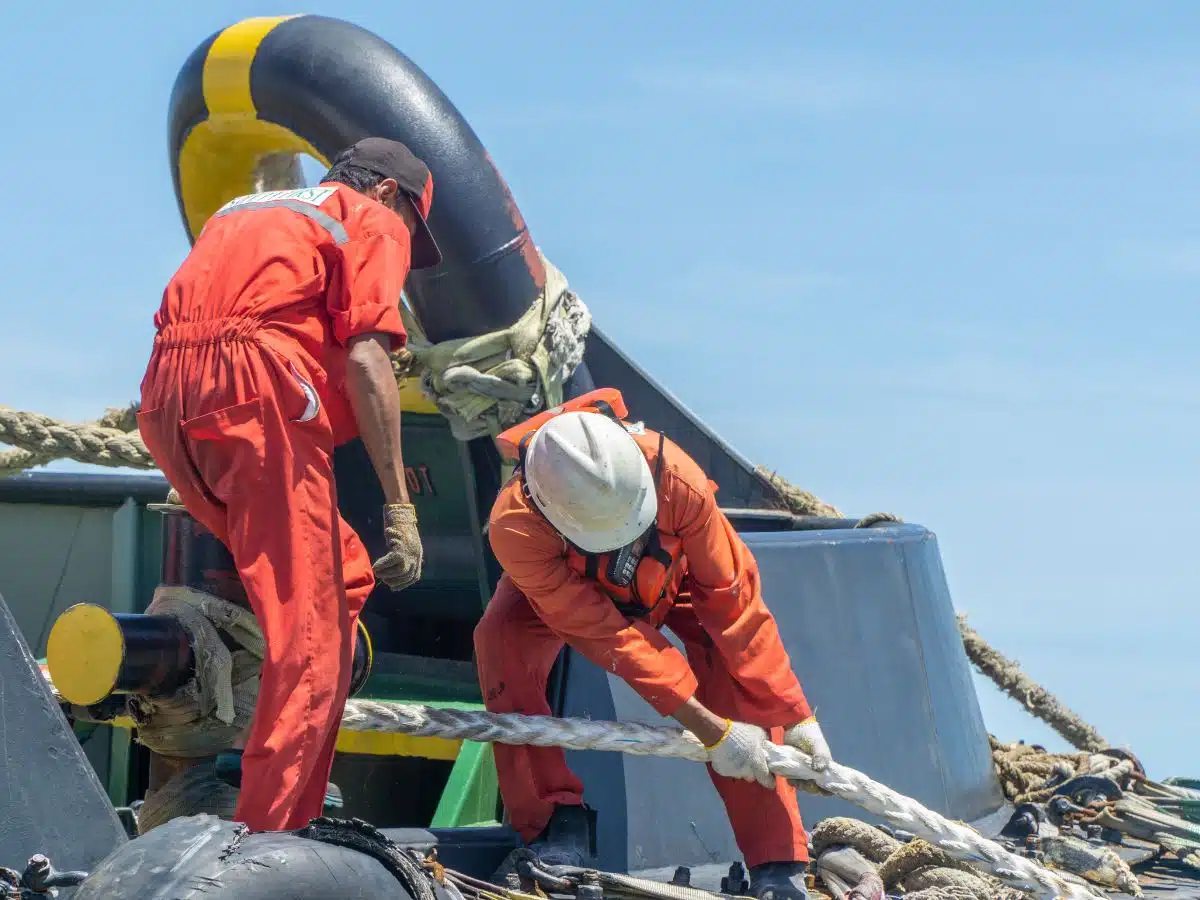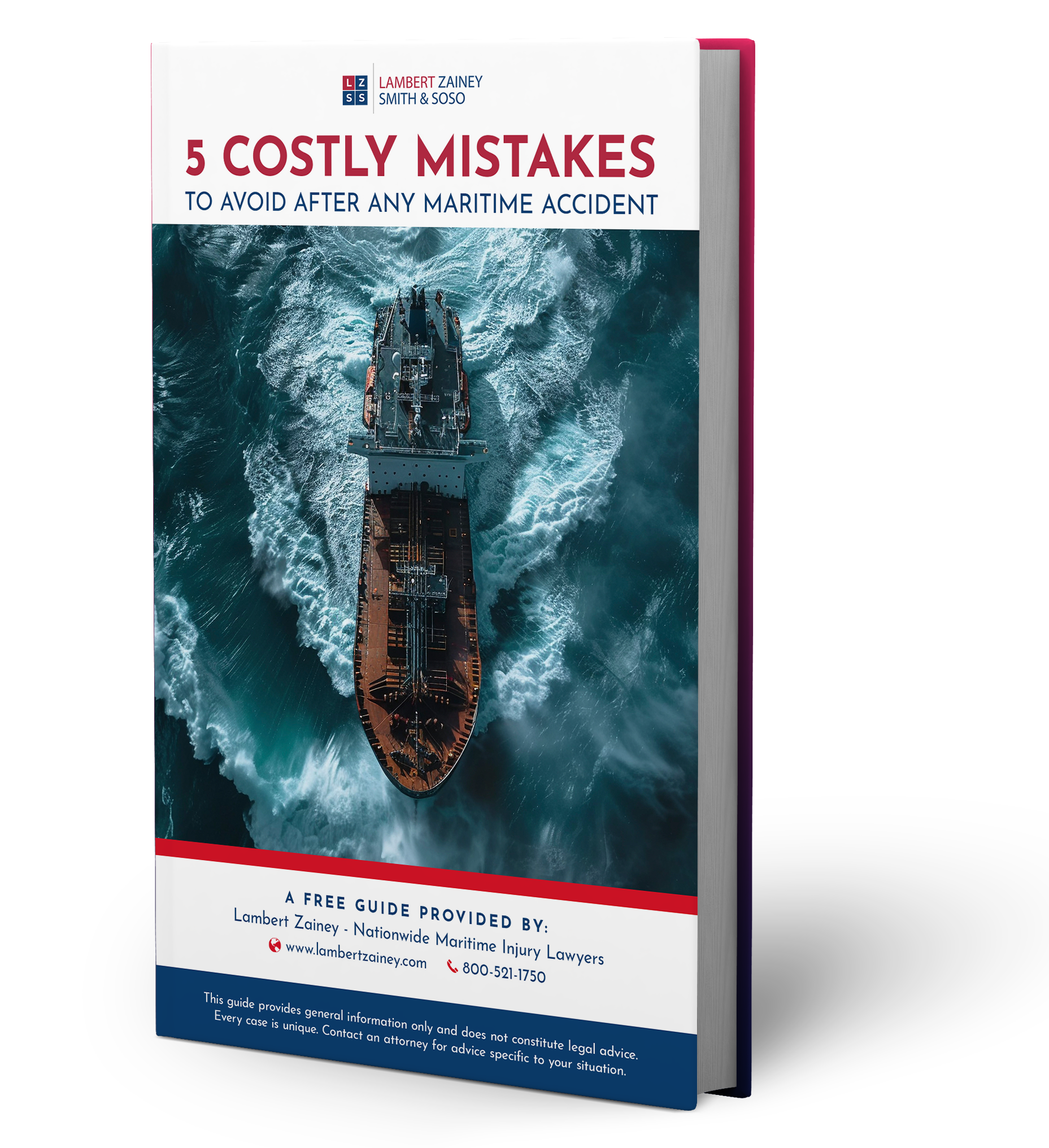With springtime comes an array of wet weather conditions for maritime workers. Along the Gulf Coast, heavy rains and choppy waters are a common occurrence. Protect yourself from the elements with the right wet weather gear for deckhands, from waterproof boots to rain jackets and windbreakers.
In this article, we’ll discuss the essentials for staying safe and dry on deck during the spring months.

What Does a Deckhand Do?
Deckhands are an essential part of any vessel’s crew, performing a wide range of duties to ensure that the ship runs smoothly and safely. As a deckhand, you’ll need to be prepared for anything, including inclement weather conditions like rain and wind. That’s why it’s important to have the right wet weather gear to keep you safe and dry while you’re working on deck.
Responsibilities and Roles of a Deckhand
Deckhands work under the direction of a captain or mate. They are responsible for keeping the vessel running smoothly and safely. Some common duties and responsibilities include:
1. General Cleaning and Maintenance
One of the primary responsibilities of a deckhand is to keep the vessel clean and well-maintained. This includes cleaning the deck areas and superstructures, as well as all the gear and equipment on board. Deckhands also perform routine maintenance tasks, such as painting and repairing equipment.
2. Loading and Unloading Supplies
Deckhands are responsible for loading and unloading supplies and equipment onto the vessel. This can include everything from food and fuel to heavy machinery and vehicles. They must ensure that all items are safely stowed and secured for transport.
3. Operation of Deck Equipment
Deckhands are trained in the safe operation of deck equipment, including winches, cranes, and other machinery. They must be able to operate these tools efficiently and safely to carry out their duties.
4. Standing Watch
Deckhands are required to stand watch while the vessel is underway. This means keeping a lookout for other vessels or hazards, monitoring the ship’s instruments, and reporting any issues or concerns to the captain or mate.
5. Docking the Ship
Deckhands play a crucial role in docking the ship when it arrives at its destination. They are responsible for securing the vessel to the wharf or another vessel using lines, wires, and other equipment.
6. Securing Vehicles for Transport
Deckhands who work on ferryboats are responsible for securing vehicles for transport. This involves safely loading and unloading cars, trucks, and other vehicles onto the ferry.
7. Handling Lines
Deckhands must be skilled in handling lines, wires, ratchets, and stationary winches. They use these tools to build or break tow and to moor the vessel to a wharf or another vessel.
8. Housekeeping Duties
Deckhands are sometimes responsible for housekeeping duties like cooking and laundry. This ensures that the crew has clean clothes to wear and nutritious meals to eat while they are away from home.
9. Assisting in Midstream Transfers
Deckhands may be called upon to assist with midstream fuel or passenger transfers. This involves safely transferring fuel or passengers between vessels while they are underway.
Types of Commercial Deckhand Gear
As a deckhand, there are several key pieces of wet weather gear you’ll need to keep yourself safe and dry.
Waterproof Jacket
The most important piece of gear for any deckhand is a waterproof jacket. You need a jacket that is lightweight, breathable and can keep you dry in the heaviest rain. Look for jackets made from materials like Gore-Tex or Helly Tech, which are both waterproof and breathable.
Waterproof Pants
In addition to a waterproof jacket, you should also invest in waterproof pants. These pants will keep your legs dry and prevent water from seeping in through the cuffs of your pants. Look for pants made from similar materials as your jacket.
Waterproof Boots
Your regular work boots won’t cut it when it comes to working on a wet deck. You need waterproof boots that can keep your feet dry in the wettest conditions. Look for boots made from materials like neoprene or rubber, which are both waterproof and durable.
Gloves
Working with wet hands is not only uncomfortable but also dangerous. Invest in waterproof gloves that can keep your hands dry and warm. Look for gloves that provide good grip and dexterity, so you can still handle tools and equipment with ease.
Hat
A hat is essential for protecting your head and face from the rain and sun. Look for hats that are waterproof and have a wide brim to keep water from running down your neck.
Durable Clothing
Deckhands need clothing that can withstand the wear and tear of working on the deck. Look for clothing made from tough materials like canvas or nylon. Avoid cotton, as it takes a long time to dry and can leave you feeling wet and uncomfortable.
Other Important Deckhand Gear
In addition to the above, there are a few other items you should always have on hand.
Personal Flotation Devices (PFDs)
The deck can be a dangerous place, so it’s important to always have a PFD on hand. You never know when you might need one, and having one on you at all times could save your life.
Radio
Having access to a portable radio is important for communicating with other deckhands and the rest of the crew. If there is an emergency situation or something needs to be done immediately, you’ll have a way to let everyone know.
Safety Glasses
Eye protection is key when working on the deck, as debris can fly up and into your eyes without warning. Safety glasses can help protect against this, and they’re also useful for blocking out the sun’s rays during long days at sea.
Tips for Choosing the Right Wet Weather Gear
It is essential to invest in high-quality wet weather gear that is specifically designed for maritime workers. This gear should be durable, waterproof, and breathable to ensure your comfort and safety while working on the water.
Features Deckhands Should Look For In Wet Weather Gear
Here are some features deckhands should look for when choosing wet weather gear:
Maintaining Your Wet Weather Gear
Once you have chosen the right wet weather gear, it is essential to maintain it properly to ensure its longevity and effectiveness. Here are some tips on how to care for your wet weather gear:
Who Is Responsible for Providing Deckhands with the Right Gear?
As a deckhand, it’s important to have the right wet weather gear to keep you safe and dry while working on a commercial vessel. But who is responsible for providing this gear? While there may not be a specific law that requires maritime employers to provide wet weather gear, they are required by OSHA to provide personal protective equipment that is necessary to protect workers from job-related hazards.
To ensure your employer is fulfilling their responsibility, here are some steps you can take:
Remember, your safety is always a top priority.
Why Wet Weather Gear Is So Important
Working on a ship during wet conditions can be hazardous for deckhands for many reasons, including:
Working in wet weather on a ship can lead to a variety of injuries.
Slips and falls are common, especially on wet surfaces. If not careful, a worker could slip and fall onto hard surfaces or objects, resulting in bruises, cuts, or broken bones.
Working in wet weather also increases the risk of hypothermia or other cold-related illnesses. Proper protective gear, such as waterproof clothing and insulated boots, can reduce the risk of these injuries.
In addition to wearing the proper wet weather gear, deckhands should be aware of their surroundings and use caution when walking on wet surfaces. If a deckhand experiences any signs of injury, they should seek medical attention immediately.
Get Our FREE Guide to Protect Your Claim
What you do after an accident is critical. Insurance companies will try to get you to make mistakes that can hurt your claim. Our free guide can help you avoid these traps.
Download our complimentary guide: “5 Costly Mistakes to Avoid After Any Maritime Accident” to arm yourself with the knowledge you need to protect your rights.
Protecting Your Rights After an Injury
If you are a deckhand working on a ship in wet weather conditions, it is important to take the necessary precautions to protect yourself from potential hazards. However, accidents can still happen despite your best efforts.
If you have been injured while working as a deckhand, it is crucial to seek legal representation from experienced Louisiana maritime lawyers at Lambert Zainey Smith & Soso. We have extensive knowledge and experience in handling all types of maritime injury cases. Our attorneys will work tirelessly to ensure that you receive the compensation you deserve for your injuries, lost wages, and pain and suffering. Don’t wait until it’s too late to protect your legal rights. Contact us today to schedule a consultation and let us help you get the justice you deserve.
With springtime comes an array of wet weather conditions for maritime workers. Along the Gulf Coast, heavy rains and choppy waters are a common occurrence. Protect yourself from the elements with the right wet weather gear for deckhands, from waterproof boots to rain jackets and windbreakers.
In this article, we’ll discuss the essentials for staying safe and dry on deck during the spring months.

What Does a Deckhand Do?
Deckhands are an essential part of any vessel’s crew, performing a wide range of duties to ensure that the ship runs smoothly and safely. As a deckhand, you’ll need to be prepared for anything, including inclement weather conditions like rain and wind. That’s why it’s important to have the right wet weather gear to keep you safe and dry while you’re working on deck.
Responsibilities and Roles of a Deckhand
Deckhands work under the direction of a captain or mate. They are responsible for keeping the vessel running smoothly and safely. Some common duties and responsibilities include:
1. General Cleaning and Maintenance
One of the primary responsibilities of a deckhand is to keep the vessel clean and well-maintained. This includes cleaning the deck areas and superstructures, as well as all the gear and equipment on board. Deckhands also perform routine maintenance tasks, such as painting and repairing equipment.
2. Loading and Unloading Supplies
Deckhands are responsible for loading and unloading supplies and equipment onto the vessel. This can include everything from food and fuel to heavy machinery and vehicles. They must ensure that all items are safely stowed and secured for transport.
3. Operation of Deck Equipment
Deckhands are trained in the safe operation of deck equipment, including winches, cranes, and other machinery. They must be able to operate these tools efficiently and safely to carry out their duties.
4. Standing Watch
Deckhands are required to stand watch while the vessel is underway. This means keeping a lookout for other vessels or hazards, monitoring the ship’s instruments, and reporting any issues or concerns to the captain or mate.
5. Docking the Ship
Deckhands play a crucial role in docking the ship when it arrives at its destination. They are responsible for securing the vessel to the wharf or another vessel using lines, wires, and other equipment.
6. Securing Vehicles for Transport
Deckhands who work on ferryboats are responsible for securing vehicles for transport. This involves safely loading and unloading cars, trucks, and other vehicles onto the ferry.
7. Handling Lines
Deckhands must be skilled in handling lines, wires, ratchets, and stationary winches. They use these tools to build or break tow and to moor the vessel to a wharf or another vessel.
8. Housekeeping Duties
Deckhands are sometimes responsible for housekeeping duties like cooking and laundry. This ensures that the crew has clean clothes to wear and nutritious meals to eat while they are away from home.
9. Assisting in Midstream Transfers
Deckhands may be called upon to assist with midstream fuel or passenger transfers. This involves safely transferring fuel or passengers between vessels while they are underway.
Types of Commercial Deckhand Gear
As a deckhand, there are several key pieces of wet weather gear you’ll need to keep yourself safe and dry.
Waterproof Jacket
The most important piece of gear for any deckhand is a waterproof jacket. You need a jacket that is lightweight, breathable and can keep you dry in the heaviest rain. Look for jackets made from materials like Gore-Tex or Helly Tech, which are both waterproof and breathable.
Waterproof Pants
In addition to a waterproof jacket, you should also invest in waterproof pants. These pants will keep your legs dry and prevent water from seeping in through the cuffs of your pants. Look for pants made from similar materials as your jacket.
Waterproof Boots
Your regular work boots won’t cut it when it comes to working on a wet deck. You need waterproof boots that can keep your feet dry in the wettest conditions. Look for boots made from materials like neoprene or rubber, which are both waterproof and durable.
Gloves
Working with wet hands is not only uncomfortable but also dangerous. Invest in waterproof gloves that can keep your hands dry and warm. Look for gloves that provide good grip and dexterity, so you can still handle tools and equipment with ease.
Hat
A hat is essential for protecting your head and face from the rain and sun. Look for hats that are waterproof and have a wide brim to keep water from running down your neck.
Durable Clothing
Deckhands need clothing that can withstand the wear and tear of working on the deck. Look for clothing made from tough materials like canvas or nylon. Avoid cotton, as it takes a long time to dry and can leave you feeling wet and uncomfortable.
Other Important Deckhand Gear
In addition to the above, there are a few other items you should always have on hand.
Personal Flotation Devices (PFDs)
The deck can be a dangerous place, so it’s important to always have a PFD on hand. You never know when you might need one, and having one on you at all times could save your life.
Radio
Having access to a portable radio is important for communicating with other deckhands and the rest of the crew. If there is an emergency situation or something needs to be done immediately, you’ll have a way to let everyone know.
Safety Glasses
Eye protection is key when working on the deck, as debris can fly up and into your eyes without warning. Safety glasses can help protect against this, and they’re also useful for blocking out the sun’s rays during long days at sea.
Tips for Choosing the Right Wet Weather Gear
It is essential to invest in high-quality wet weather gear that is specifically designed for maritime workers. This gear should be durable, waterproof, and breathable to ensure your comfort and safety while working on the water.
Features Deckhands Should Look For In Wet Weather Gear
Here are some features deckhands should look for when choosing wet weather gear:
Maintaining Your Wet Weather Gear
Once you have chosen the right wet weather gear, it is essential to maintain it properly to ensure its longevity and effectiveness. Here are some tips on how to care for your wet weather gear:
Who Is Responsible for Providing Deckhands with the Right Gear?
As a deckhand, it’s important to have the right wet weather gear to keep you safe and dry while working on a commercial vessel. But who is responsible for providing this gear? While there may not be a specific law that requires maritime employers to provide wet weather gear, they are required by OSHA to provide personal protective equipment that is necessary to protect workers from job-related hazards.
To ensure your employer is fulfilling their responsibility, here are some steps you can take:
Remember, your safety is always a top priority.
Why Wet Weather Gear Is So Important
Working on a ship during wet conditions can be hazardous for deckhands for many reasons, including:
Working in wet weather on a ship can lead to a variety of injuries.
Slips and falls are common, especially on wet surfaces. If not careful, a worker could slip and fall onto hard surfaces or objects, resulting in bruises, cuts, or broken bones.
Working in wet weather also increases the risk of hypothermia or other cold-related illnesses. Proper protective gear, such as waterproof clothing and insulated boots, can reduce the risk of these injuries.
In addition to wearing the proper wet weather gear, deckhands should be aware of their surroundings and use caution when walking on wet surfaces. If a deckhand experiences any signs of injury, they should seek medical attention immediately.
Get Our FREE Guide to Protect Your Claim
What you do after an accident is critical. Insurance companies will try to get you to make mistakes that can hurt your claim. Our free guide can help you avoid these traps.
Download our complimentary guide: “5 Costly Mistakes to Avoid After Any Maritime Accident” to arm yourself with the knowledge you need to protect your rights.
Protecting Your Rights After an Injury
If you are a deckhand working on a ship in wet weather conditions, it is important to take the necessary precautions to protect yourself from potential hazards. However, accidents can still happen despite your best efforts.
If you have been injured while working as a deckhand, it is crucial to seek legal representation from experienced Louisiana maritime lawyers at Lambert Zainey Smith & Soso. We have extensive knowledge and experience in handling all types of maritime injury cases. Our attorneys will work tirelessly to ensure that you receive the compensation you deserve for your injuries, lost wages, and pain and suffering. Don’t wait until it’s too late to protect your legal rights. Contact us today to schedule a consultation and let us help you get the justice you deserve.









